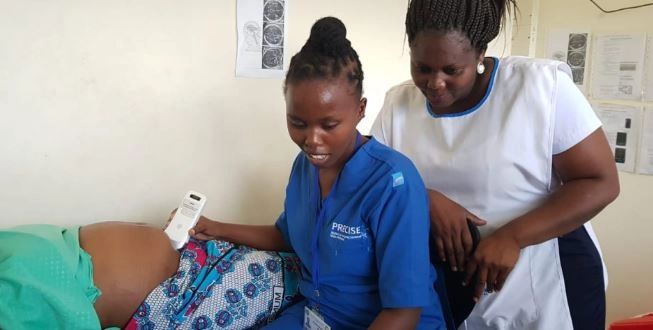You are here:
- Home
- >
- Knowledge Hub
- >
- Case Studies
- >
- TraCer – The Birth of a New Device.
An inexpensive, handheld device allowing non-experts to assess the gestational age of a foetus is being created by University of Oxford researchers with technical support from OCC.
Knowing the gestational age of the foetus is an important aspect of modern maternity care. This is especially true when it comes to making decisions about when to intervene to reduce obstetric complications, deliver the baby or prevent stillbirth. In the western world, sonographers use high-precision ultrasound scans in the first trimester of pregnancy to estimate gestational age and subsequently help monitor foetal health. But in most lower-middle-income countries, women do not have this early scan and trained sonographers with high-resolution equipment are thin on the ground. Because of this, treating women who are uncertain about the stage of their pregnancy can be difficult.
The handheld device, which comprises a low-cost ultrasound probe and a tablet computer, will allow non-experts working in the field to acquire short ultrasound video clips of the foetal brain. These clips will allow computer-led analysis back in the UK to determine gestational age.

The creation of next-generation ultrasound systems that use machine learning to tackle unmet clinical needs in the developing world is the goal of an Oxford University team led by Alison Noble, Technikos Professor of Biomedical Engineering, and Aris Papageorghiou, Associate Professor of Fetal Medicine. This particular project is funded by the UK government’s Global Challenges Research Fund as part of the PRECISE network initiative, which seeks to build individual and institutional research capacity across Africa and the UK through a shared pregnancy research programme.
“In the TraCer project we’re seeking to use our very portable probe-and-tablet device to measure the TransCerebellar diameter, a structure in the foetal brain which changes with gestational age,” explains Professor Noble. “This is a reliable parameter but it’s small and difficult to measure. We’re currently carrying out a research study in Kenya and The Gambia in which a research technician records short video clips of the foetal brain, which are sent back to us for analysis.”
“We believe we can use machine-learning techniques to analyse these videos to determine gestational age, but we need to assess how accurately we can do this and also investigate the usability of the device in the field,” she adds. “We already had an algorithm that allowed us to take a digital video recording using the ultrasound probe, but OCC’s expertise in presenting the method as a display on a notebook device for a non-expert user has been an essential part of the project.”
OCC’s role was to create an app for the TraCer study that could gather data, allow the user to check the video was of good enough quality and then store and upload that information for analysis in the UK. But there were other considerations. For example, it was important to store but not show the data to the user because in some countries it’s illegal to use ultrasound for foetal gender identification.
“Our Innovation Delivery Team is very experienced at transforming research software into commercial applications, so we employed our user research skills and our understanding of how to make something accessible to a non-expert operator, together with our technical proficiency in imaging, in order to co-design with the researchers a prototype system for clinical evaluation,” says Rachael Bartholomew, OCC’s Head of Client Services. “We produced a cross-platform app using the React Native framework. It receives and displays live image data streamed from an ultrasound probe over WiFi, allows users to record foetal scan videos and then uploads those files to the UK via SFTP for analysis. Because data security was a key concern, encryption is used for both the storage and transfer of the foetal ultrasound recordings.”
The project is now in phase 2 – making improvements based on initial user feedback and scrutinising the quality of the video images.